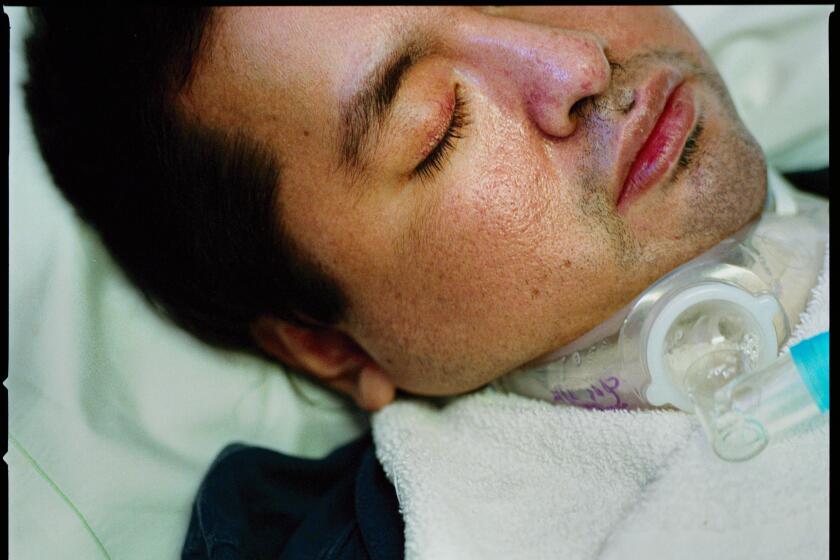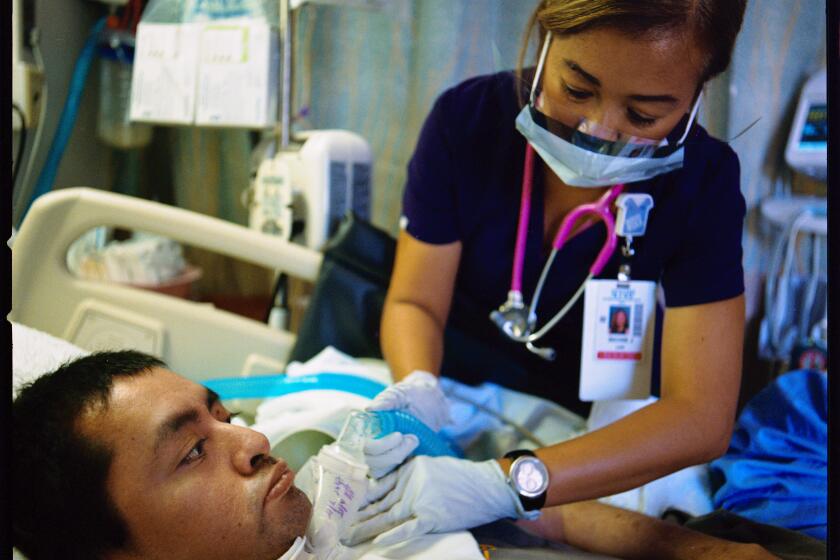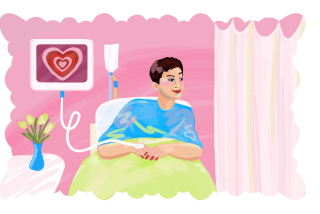For months, he lingered in a purgatory between wakefulness and nothingness
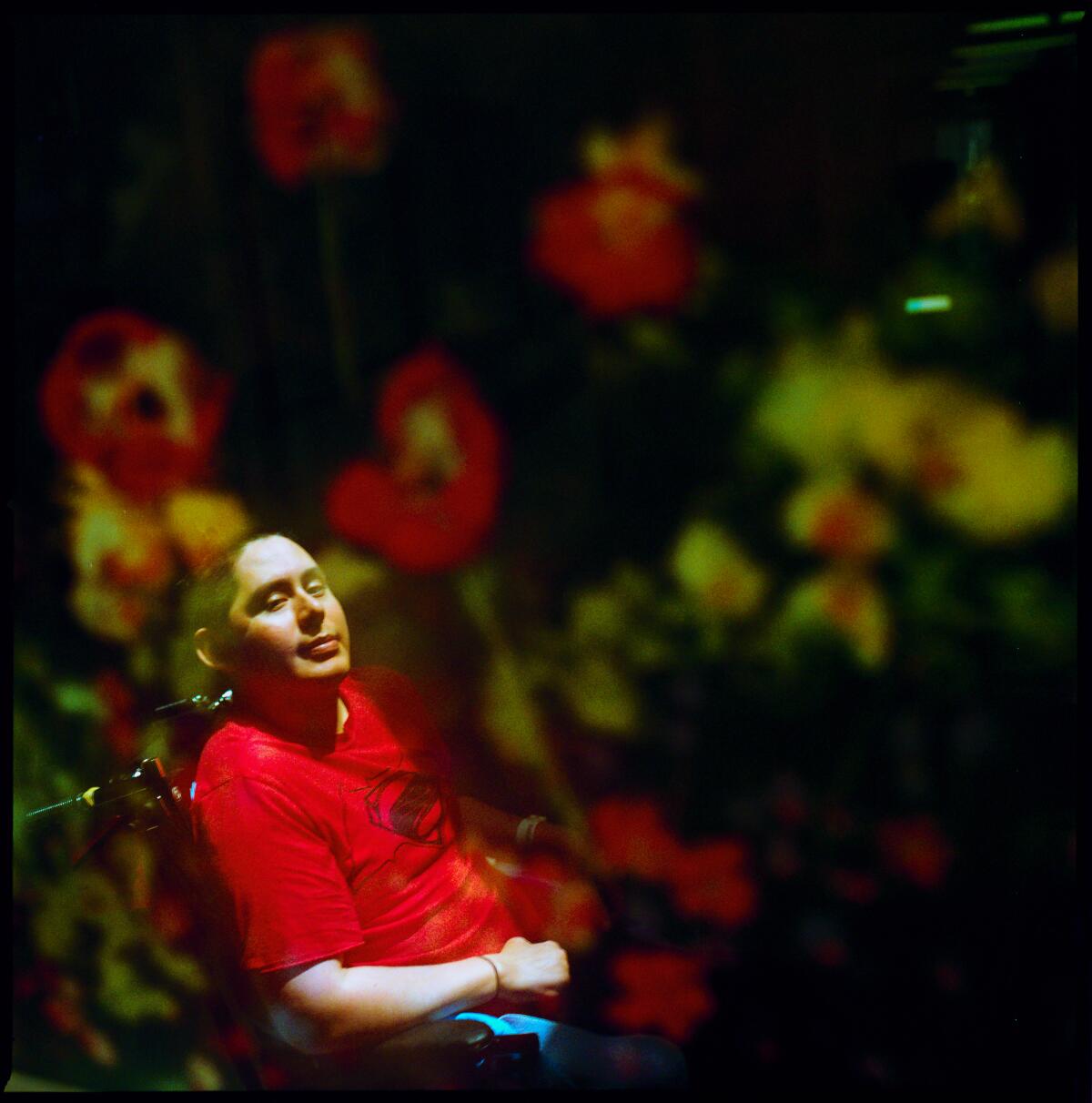
- Share via
SAN DIEGO — Omar Salgado moved in slow motion as he turned toward the music. The radio on the nightstand was on a Spanish-language station. A Latin polka was playing. Salgado’s head shifted a mere three inches, with each quarter inch looking painfully difficult, as though his head were attached to his neck with corroded screws that might crack.
He hadn’t moved in the month since he’d been admitted to the Villa Coronado Skilled Nursing Facility in San Diego. I had assumed Salgado wasn’t conscious and paid little attention to him. I was there to document the life of his roommate — a man who’d been on life support for nearly 16 years.
Salgado’s gaze had always been fixed on the ceiling — his emaciated body statue-like, his two legs wrapped together in a soft splint, and his arms folded across his chest as though a mortician had posed him.
He’d been in a car accident. His liver was slashed. His spine, ribs and a hip were broken. He had something called “a diffuse axonal shear” injury to his brain — the kind of injury that usually puts people into a vegetative state.
I leaned over Salgado and stared into his face. His eyes were large and brown, his cheeks hollow, his chin narrow. He looked something like a doe: innocent and beseeching, his wakefulness on the verge of vanishing if I moved too fast.
“Omar, blink once if you can hear me,” I said.
He blinked.
“Blink if your name is Omar.”
He blinked again.
Salgado woke on Jan. 18, 2016, about three months after his accident, and one day after he turned 22. He was living in a special unit for people on life support, most of whom have feeding and breathing tubes.
Salgado had defied the odds. Not only had he lived, he was emerging from his semiconscious state. But his is not a story about a miracle — it’s a story about medicine’s inability to accurately diagnose consciousness and treat those who do wake up but linger in a purgatory between wakefulness and nothingness.
Finding out his name turned out to be the easy part. The tough part was navigating the blurred lines that separate consciousness from unconsciousness — and figuring out whether his smile was really a smile.
About 40% of the people diagnosed as being in a vegetative state — a neurological condition in which patients are awake but show no signs of being aware of themselves or their environment — are conscious at least some of the time, according to a growing body of research. But like Salgado, they have no way of indicating they’re aware.
Salgado couldn’t speak. According to his medical file, no one had ever seen him willingly move any part of his body. It was just luck that I happened to see him turn his head that day.
Doctors have long relied on behavior to measure consciousness — in other words, they ask patients to respond to commands, such as lift your right hand or move your left toe.
But that method is flawed, said Martin Monti, an associate professor in UCLA’s Department of Psychology and Department of Neurosurgery.
How can a patient who can’t move tell you he’s there? Monti asked.
What’s more, once consciousness is established, there is little or no therapy offered to patients to treat their condition or accelerate their awakening, he said.
But Monti and his co-researcher, Caroline Schnakers, who is also his wife, are hoping to change that. They are partnering on a research project that uses an ultrasound device the size of a hockey puck to shake neurons in the brain back into action.
They’ve used the technique on several brain-injured people in Southern California, and all but one showed signs of increased awareness, including one man who fully recovered consciousness.
“It is a simple idea,” Monti said, “but it’s not any simpler than giving a medicine.”
Based on what he went through, I would not have expected him to live.
— Det. Bryan Hendrix of the Oceanside Police Department, on Omar Salgado’s accident
The accident
On the night of Nov. 2, 2015, Salgado was riding his bike in the median of a four-lane highway. It was dark on that stretch of State Route 76 near Oceanside.
A car was making a left turn where the highway intersects with another four-lane roadway. The driver, a man in his 20s, swerved when he saw Salgado, but it was too late. Salgado was airborne. His bike landed on the shoulder and he landed on the highway. He wasn’t wearing a helmet. Another car, traveling 55 mph, ran over him.
“Based on what he went through, I would not have expected him to live,” said Det. Bryan Hendrix, the Oceanside police officer who was first on the scene.
Salgado had no drugs or alcohol in his system. He was unconscious and had no identification with him. Police ran his fingerprints and learned he’d been in trouble with the law before, mostly for minor offenses like being drunk in public.
I showed Hendrix a video I’d taken of Salgado in the nursing home. He was attached to tubes, his skin stretched across bone. He looked like a corpse.
“I told my wife to pull the plug if I ever end up like that,” Hendrix said. He’d investigated enough accidents to know that people who suffered injuries as severe as Salgado’s might live but never really recover.
In his mug shot, Salgado was a 5-foot-6, 120-pound troubled-looking kid. In the nursing home, he was a fragile young man whose body constantly shivered; who was dangerously thin (he weighed 96 pounds) because his body was mysteriously shedding weight; whose brown eyes seemed to grow in size as the hollows of his sockets became more pronounced.
He looked scared.
At the time of the accident, Salgado was homeless — estranged from an aunt and uncle who raised him. They visited him in the ICU at Scripps Memorial Hospital in San Diego as he lay unconscious for weeks. They met with doctors to discuss withdrawing life support when it appeared their nephew had no hope of ever waking up.
But one day, a nurse noticed that Salgado was following her movements with his eyes. In the medical world, this is called tracking, and it’s an indicator that Salgado was emerging from a vegetative state.
Instead of discontinuing medical treatment and allowing Salgado to die, doctors transferred him to the nursing home. His aunt and uncle stopped visiting after that, according to nursing home staff. For nearly three years, no one from Salgado’s family came to see him.
Blink twice if you want the TV on
Salgado occupied the middle bed in Room 20, with an old man the staff called Papa to his right, and the man I was reporting on — known only as Sixty-Six Garage — to his left. I largely ignored Salgado, making the occasional note about him on my laptop. I noticed his scar first. It extended from the corner of his left eye to his hairline. Unlike the cuts on his hands and feet, which still appeared fresh from his accident, the scar looked old, embedded in Salgado’s olive skin like a birthmark.
The “new roommate looks exactly how he looked when I left three days ago ... eyes open, staring up at the ceiling,” I wrote on Christmas Day 2015.
A new L.A. Times Studios podcast about the search for a man’s identity.
There were times Salgado’s face dripped with sweat, even though he shivered uncontrollably. He had stage four bedsores (a wound that may “expose muscle, bone or tendons,” according to the Mayo Clinic) on his buttocks. They had merged to form one large hole that was perpetually infected.
I usually had my back to Salgado, my chair pulled up beside Sixty-Six Garage’s bed. I don’t know why on that late January afternoon I changed my routine and placed my chair so I could see both men.
If Salgado’s movement had been less deliberate, if his head had dropped or jerked to the side as if he’d fallen asleep sitting up, it might have passed for a reflex. But this was different.
“Must show you something,” I texted to Ed Kirkpatrick, the nursing home’s director.
Kirkpatrick was used to getting text messages like these. I’d been reporting in the nursing home for nearly two years and often shared my observations.
While I waited for Kirkpatrick to arrive, I kept asking Salgado questions because I was afraid he’d slip away if I stopped talking.
“Blink once if you know you’re in the hospital.”
He blinked.
”Blink if you know you were in an accident.”
He blinked again.
I told Salgado he was being taken care of and that he was going to get better. But if you’d been there to see him, you would know I was lying.
Watching his body wither away all those weeks, I was afraid to ask the obvious question: Did he want to live or die?
There is no money for rehabilitation once they get to this place. Medi-Cal only pays to keep them alive.
— Ed Kirkpatrick, nursing home director
When Kirkpatrick arrived, he held up three fingers and asked Salgado to blink twice if he saw three fingers. He blinked twice. Kirkpatrick asked him to squeeze his hand. Nothing.
“Blink twice if you’re trying to squeeze my hand,” Kirkpatrick said.
Salgado blinked twice.
But Kirkpatrick seemed unimpressed.
“What does it matter?” he asked.
Salgado will never be able to walk, tie his shoes, go to the bathroom on his own — he’ll never speak because his brain injury has left him mute, Kirkpatrick said.
“There is no money for rehabilitation once they get to this place. Medi-Cal only pays to keep them alive,” he said.
After Kirkpatrick left the room, I returned to Salgado’s bedside.
“Blink twice if you want the TV on,” I said.
He blinked twice.
“Should I read to you the next time I come?”
He blinked again.
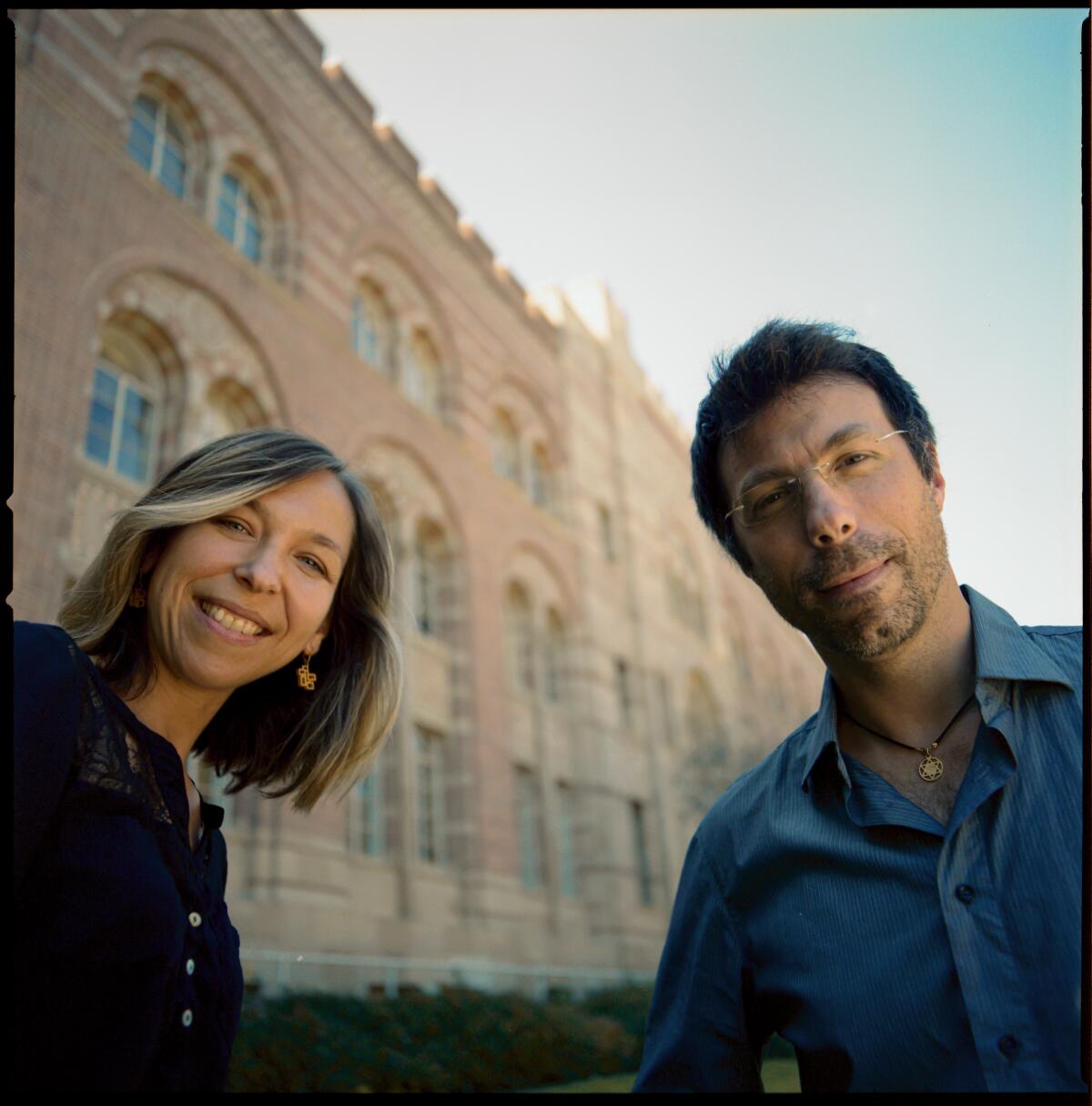
The ultrasonic hockey puck
Caroline Schnakers was a neuropsychologist in Belgium when studies began appearing that showed doctors were misdiagnosing consciousness: People who were conscious were being diagnosed as being in a vegetative state. The news hit Schnakers especially hard because in Belgium, euthanasia is legal and families may have made end-of-life decisions based on a misdiagnosis.
“The first thing I thought, and I know a lot of clinicians thought the same thing as me, is how many patients did I miss?” she said.
Schnakers, assistant director of research at the Casa Colina Hospital and Centers for Healthcare in Pomona, went on to conduct her own studies. She found that about 40% of the people who are diagnosed in a vegetative state are minimally conscious, meaning they drift in and out of consciousness.
Schnakers is also an expert on diagnosing consciousness using the JFK Coma Recovery Scale Revised. It’s a scoring system that can detect nuanced signs of awareness, like object recognition.
For example, when administering the test, Schnakers will hold a cup in one hand and a pen in the other. She’ll then ask patients to look at the cup. If they fix their eyes on the cup, and repeatedly do so, they score points in the visual function category.
Together, Schnakers and Monti are trying to determine whether the ultrasonic device, Monti’s hockey puck, can reignite brain function by exciting neurons in the thalamus, the control center for the brain and integral for consciousness.
“So we try to reignite that by literally massaging the thalamus with the ultrasound,” Monti said.
In 2016, Monti’s work made headlines when a 25-year-old brain-injured man regained consciousness just days after being treated with his device.
Bradley Crehan had been hit by a car in Santa Monica and part of his skull was removed to relieve pressure on his brain. He was placed in a medically induced coma, and when he woke 19 days later, he showed few signs of being able to communicate or respond to commands.
Monti placed the ultrasonic device at the right side of Crehan’s brain, aimed it at his thalamus, and pulsed 10 times at 30-second intervals. The next day, Crehan could reach toward objects and make sounds on command. Three days later he could nod his head for “yes” and shake it for “no.”
“So Bradley came back six months later and we asked him, ‘How are you feeling?’ And he said, ‘I feel just about 80% of what I was before,’” Monti said.
But there’s no way of knowing whether the ultrasound caused Crehan to suddenly wake, or whether he would have spontaneously recovered on his own.
“That’s the biggest question. We could have sung a song with my beautiful singing voice and he would have recovered anyway,” Monti joked.
Now, Monti and Schnakers want to use their technique on chronically brain-injured people — those who’ve been in a vegetative or minimally conscious state for years or even decades.
If they have success with those patients, whose chances of spontaneous recovery are almost nil, they’ll know with more certainty that the ultrasonic device is working.
So far, they’ve had positive results.
When Schnakers discussed using the experimental treatment on a middle-aged man who’d been minimally conscious for more than three years, she cautioned his wife not to get her hopes up. He’d suffered a stroke and his brain had been deprived of oxygen. Chances of recovery in this type of brain injury are not as good as in a traumatic injury where a specific part of the brain is damaged.
“I don’t expect anything,” Schnakers told the wife.
The woman agreed to let Monti attach the device to her husband’s head and “sonic” his brain 10 times for 30 seconds, each interval 30 seconds apart. The man got two treatments, one week apart.
His wife saw a dramatic improvement after the first week.
He began responding to “yes” and “no” questions by turning his head side to side and up and down.
The couple spent one evening looking at pictures, Monti said. The man began laughing at jokes.
“I just remember [the wife] saying for the first time, ‘I had a conversation with my husband,’ which is pretty powerful,” Monti said.
Another woman, in her 40s and also minimally conscious, was able to look at her mother on command after the treatment.
But one patient, who was in a vegetative state, did not appear to respond to the device, Monti said.
Monti and Schnakers are writing up their findings. They need a much larger sample to know whether their treatment is effective and whether the positive effects last over time. They’re recruiting 15 patients for a small clinical trial. If they get good results from that study, they’ll move on to a large scale double-blind trial.
Schnakers said part of the challenge is finding patients to participate in their experiments, even though California has about 125 subacute units housing more than 4,000 people on life support.
Nursing homes and doctors can be protective of their patients, Schnakers said, so getting access to them can be difficult.
The doctors “are afraid of having false hope for them,” she said.
We don’t have a neurologist who’s willing to see these patients on a regular basis.
— Dr. Ken Warm
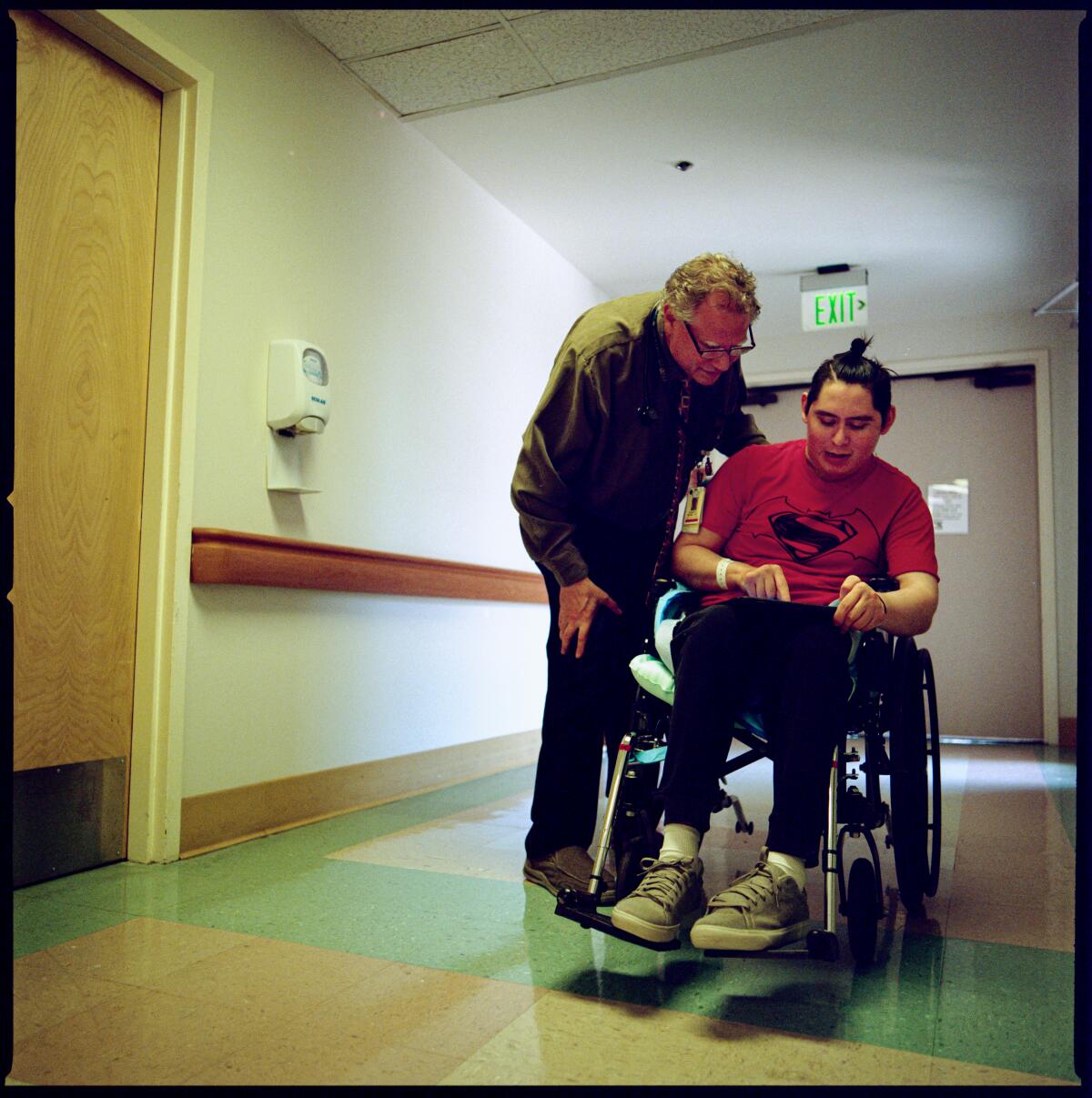
No money for treatment
Omar Salgado’s doctor, Ken Warm, speaks like a man who’s accustomed to delivering bad news. He chooses each word deliberately, often taking long pauses in mid-sentence, his language stripped bare of hyperbole.
“Unfortunately, the way you heard it — that Medi-Cal pays for us to keep him alive — that’s really true and really challenging,” Warm said.
“For every one of [these patients] I would like to do more than I’m doing,” he said.
Medi-Cal — the state’s insurance plan for the poor and disabled — pays nursing homes a daily rate to care for patients like Salgado. The Villa’s rate is about $800 a day. Some of that money can be used for rehabilitation, according to a spokesperson for the state Department of Health Care Services.
It’s up to the nursing home to decide the best treatment.
Patients at the Villa are cared for by nurses and nursing assistants, and evaluated weekly by family doctors or geriatricians. There is no regular testing by experts to gauge whether patients’ level of consciousness is changing over time.
“We don’t have a neurologist who’s willing to see these patients on a regular basis,” Warm said, because Medi-Cal reimbursement is low.
Knowing that Salgado or others on the subacute unit may in fact be conscious, Warm said, doesn’t change the outcome.
“What do you do if you know?” Warm asked.
“They’re still locked in,” he said, referring to a neurological syndrome in which a patient is conscious but can’t move or speak.
‘Your head is stinky’
At first, little changed after Salgado’s awakening. I’d tell the staff he could communicate by blinking and some tried to elicit a response. But they said he wasn’t consistent. Sometimes he’d blink and other times he’d just stare straight ahead.
On Salgado’s good days, I’d pepper him with questions: one blink for yes, two for no.
“Do you have a mom?”
One blink.
“Do you have a dad?”
One blink.
“Do you have a sister?”
One blink.
“Do you talk to your mom?”
Two blinks.
“Are you in pain?”
One blink.
Eventually, Salgado got the colostomy surgery he needed and put on weight. He stopped shivering and answered with two blinks when asked if he was in pain.
One afternoon, I heard Salgado cough. It wasn’t the gurgling rasp common among tracheostomy patients. There was depth to it, as though his vocal cords had engaged.
I went to the side of his bed and made a humming sound. I asked him to repeat it, and when he did, I recorded it with my phone. I sent the recording to Kirkpatrick, the nursing home director, with the heading: “Omar makes sounds.”
Not long after, Salgado got a speaking valve — a device that allows air to pass through the hole in his throat and engage his vocal cords.
He began to say “hi,” as though he was blowing the word out with a puff of air. One day, I asked him my name.
“Joooo Annnnn,” he said.
“What’s your name?” I asked.
“Omar.”
Salgado’s hands began to uncurl and I brought markers and scrapbooks. He scribbled at first, most of it indecipherable. Weeks later, we wrote out his three goals: to go outside, eat pizza and read a Spider-Man comic.
I showed Kirkpatrick that Salgado could read and write. I held up words in a notepad: chair, skateboard, butterfly, and Salgado read them aloud as Kirkpatrick watched. It was mounting evidence that Salgado no longer belonged on the subacute unit.
There have been many firsts for Salgado since his awakening: the first time he tasted grape juice; the first time he danced by moving his shoulders side to side when a song he knew came on the radio; the first time he told me he loved me, and I asked him to repeat it several times, partly because his voice was so soft and partly because I needed to hear it more than once; the first time he hugged me, on the day after Thanksgiving in 2016, and I was surprised by the strength of his embrace; and the first time he used an iPad (paid for by a GoFundMe campaign) and typed, “Hello beautiful people,” on his very own Facebook account.
More than a year after Salgado awakened, he was transferred to another unit at the nursing home where he would get regular physical and speech therapy. His voice is sometimes faint and raspy, but he speaks with clarity and agency. He has learned to operate a wheelchair and he’s had surgery to close the hole in his throat. He’s eating solid food: spinach, fried beans, eggs and applesauce. He spends his time putting together puzzles and watching television.
At last count, Salgado had made 400 friends on Facebook, many of them scantily clad women. At first his posts were sometimes gibberish:
“Your head is stinky.”
Sometimes profound:
“Tomorrow we’ll go to the park in our imagination.”
Often, they were inappropriate.
“God is my dick.”
Now, Salgado’s Facebook posts range from contemplating whether he should get a “man bun” to things more cosmic, such as “Love is art.”
Sometimes he’s lonely or upset about the state in which he finds himself:
“I feel terrible, anxious to walk and I can’t move my legs ... I feel like I’m about to be invalid for the rest of my life.”
Late last year Salgado made the most incredible connection of all on Facebook: He tracked down an older sister he hadn’t seen in more than a decade. And finally, he had his first visitors at the nursing home — the sister and her young children.
Salgado has fulfilled all of his three goals: He’s read several Spider-Man comic books, and he’s been on outings with other nursing home residents, including to the San Diego County Fair. Earlier this year, he had his first slice of pizza.
Human connection
I’ll never know whether Salgado’s slow turn toward the radio was his way of shouting to the world, “I’m still here!” Or was he just able to hear the music for the first time? What if I hadn’t been there to notice?
Warm pondered a similar question.
“Why is he better? Was it just time?” he recently asked. “Was it that he made this bond with you?”
If human connection did accelerate Salgado’s awakening, Warm said, how does medicine “recreate it professionally?”
I moved to New York last year and I visit Salgado less often now. He frequently sends me Facebook messages. Sometimes he wishes me good night, or asks me what’s new.
Or, he wants to know, “When are you coming?”
“I miss you.”
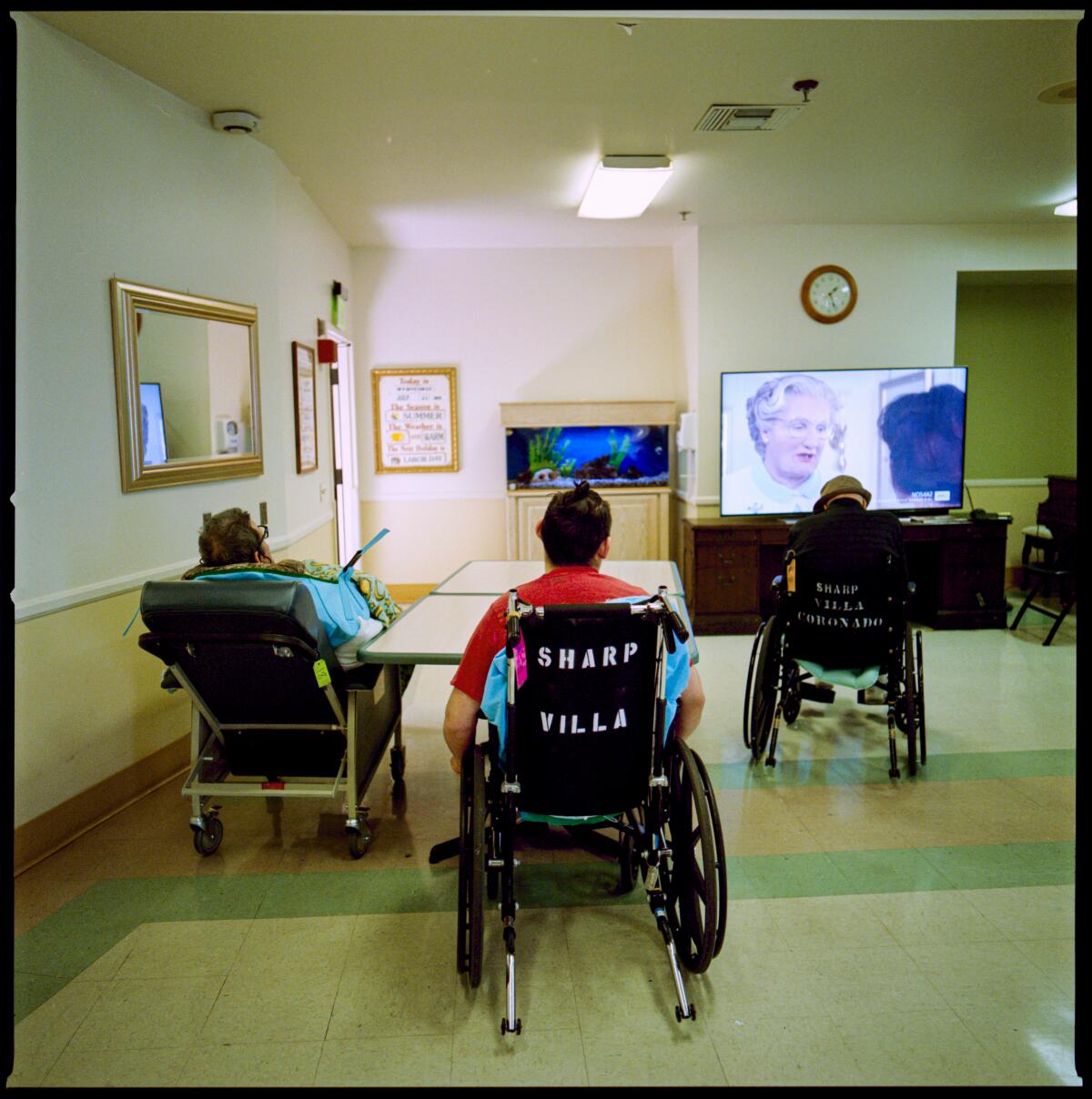
More to Read
Sign up for Essential California
The most important California stories and recommendations in your inbox every morning.
You may occasionally receive promotional content from the Los Angeles Times.
